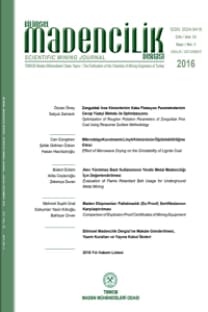ZONGULDAK İNCE KÖMÜRLERİNİN KABA FLOTASYON PARAMETRELERİNİN CEVAP YÜZEYİ METODU İLE OPTİMİZASYONU
Bu çalışmada; Zonguldak ince kömürlerinin (tane boyutu; -0,5 mm, kül; % 46,10) kaba flotasyon
parametrelerinin modellenmesi ve optimizasyonu cevap yüzeyi metodu ile araştırılmıştır.
Bağımsız değişkenler; gazyağımiktarı (x1),metilizobütilkarbinolmiktarı (x2), sodyumsilikatmiktarı
(x3) ve katı oranının (x4) bağımlı değişkenler; kaba konsantre ağırlığı (y1), kaba konsantre külü (y2)
ve yanabilir verim (y3) üzerindeki etkisi merkezi bileşik dönersel tasarımı ile araştırılmış ve her bir
bağımlı değişken için model eşitlikleri geliştirilmiştir. Sonuçlar varyans analizi ile değerlendirilmiş
olup, modellerin doğruluğu ve geçerliliği tartışılmış ve üç boyutlu grafikleri çizilmiştir. Design
Expert 8.0.7.1 yazılım programı ile optimum yaklaşımda; ağırlıkça % 64,54 kaba konsantre
elde edileceği ve bunun kül oranının % 23,88 ve yanabilir verimin de % 91,78 değerlerinde elde
edileceği hesaplanmıştır. Bu sonuçlara, 200 g/t gazyağı, 125 g/t MIBC, 1846 g/t sodyum silikat
miktarlarında ve % 10 katı oranında çalışıldığında ulaşılacağı belirlenmiştir
Anahtar Kelimeler:
Kömür flotasyonu, cevap yüzeyi metodu, modelleme, optimizasyon
OPTIMIZATION OF ROUGHER FLOTATION PARAMETERS OF ZONGULDAK FINE COAL USING RESPONSE SURFACE METHODOLOGY
In this study; modeling and optimization of rougher flotation parameters of Zonguldak fine coal
(particle size; -0.5mm, ash content; 46.10 %) was investigated by using response surfacemethod.
Central composite rotatable design was employed to evaluate the influence of independent
variables; kerosene dosage (x1), methyl isobutyl carbinol (MIBC) dosage (x2), sodium silicate
dosage (x3) and the solid ratio (x4) on the dependent variables; the weight of the rougher
concentrate (y1), the ash content of the rougher concentrate (y2), and the combustible yield (y3).
Model equations were developed for each dependent variables and then results were evaluated
by using analysis of variance. The accuracy and validity of the models were discussed and threedimensional
graphics were plotted. The optimum conditions were calculated by using Design
Expert 8.0.7.1 software program. It was determined rougher concentrate could be obtained with
the weight of 64.54 %, the ash content of 23.88 % and the combustible yield of 91.78 %. These
results were taken with the help of parameters; 200 g/t diesel oil, 125 g/t MIBC, 1846 g/t sodium
silicate and 10 % solid ratio.
Keywords:
Coal flotation, response surface methodology, modeling, optimization,
___
- Anon, 2016. https://www.chem.mtu.edu/chem_eng/ faculty/kawatra/Flotation_Fundamentals.pdf. Aslan, N., Çifçi, F., Yan, D., 2008. Optimization of process parameters for producing graphite concentrate using response surface methodology. Separation and Purification Technology, 59, 9–16.
- Baş, C., 2010. Cevap Yüzeyi Tasarımları ve Sinir Ağları Yaklaşımı. Ankara Üniversitesi Fen Bilimleri Enstitüsü, Doktora Tezi, Ankara.
- Bilir, K., 2011. Kömür flotasyonunda kullanılan gazyağı miktarının oranların farkı testi ile optimizasyonu, Eskişehir Osmangazi Üniversitesi Mühendislik Mimarlık Fakültesi Dergisi, Cilt: XXIV, No: 1.
- Box, G.E.P., Hunter, J.S., 1957. Multi-factor experimental design for exploring response surfaces. Ann. Math. Stat., 28, 195–241.
- Çilek, E.C., 2013. Mineral Flotasyonu, Süleyman Demirel Üniversitesi, Mühendislik Fakültesi, yayın no: 59, Isparta.
- Obeng, D.P., Morrell, S., Napier, T.J.N., 2005.
- Application of central composite rotatable design to modeling the effect of some operating variables on the performance of the three-product cyclone, Int. J. Miner. Process., 76, 181-192.
- Erdoğan, F., 2007. Yükseltilmiş D-Optimal Dizayn Yöntemi Kullanılarak Mühendislik Dizaynlarında Etkinliğin Geliştirilmesi: ‘Sentetik Jet’ Dizayn Optimizasyon Çalışması. Havacılık Ve Uzay Teknolojileri Dergisi, 3(1), 51-61.
- Erşan, M., Açıkel, Ü., 2014. R. Delemar ’In Asit Fosfataz Üretimi Ve Zn(Iı) Biyobirikiminin Cevap Yüzey Yöntemi Kullanarak Optimize Edilmesi. Gazi Üniv. Müh. Mim. Fak. Der., 29 (2), 321-329.
- Jia, R., Harris, G.H., Fuerstenau, D.W., 2002 Chemical Reagents for Enhanced Coal Flotation. International Journal of Coal Preparation and Utilization, 22:3, 123-149.
- Kemal, M., 1987. Kömür Teknolojisi, Dokuz Eylül Üniversitesi Mühendislik Mimarlık Fakültesi, MM/ MAD–87 EY 033, İzmir.
- Klimpel, R. R., 1995. The Influence of Frother Structure on Industrial Coal Flotation, High-Efficiency Coal Preparation (Kawatra, ed.). Society for Mining, Metallurgy, and Exploration, Littleton, CO, s. 141-151.
- Kural, O., 1991. Kömür, 975 sayfa, Kurtiş Matbaası, İstanbul.
- Laskowski, J.S., Miller, J.D., 1984. New Reagents in Coal Flotation, Reagents in the Mineral Industry (M. J. Jones and R. Oblatt, Eds.) The Institute of Mining and Metallurgy, s. 145-154.
- Mead, R., Pike, D.J., 1975. A biometrics invited paper. A review of response surface methodology from a biometric viewpoint, Biometrics, 31(4). 803-851.
- Naik, P.K., Reddy P.S.R., Misra, V.N., 2005. Interpretation of interaction effects and optimization of reagent dosages for fine coal flotation. Int. J. Miner. Process. 75, 83-90.
- Öney, Ö., 1993. The enrichment of Zonguldak fine coal by flotation. Yüksek Lisans Tezi, Dokuz Eylül Üniversitesi, Fen Bilimleri Enstitüsü, İzmir.
- Read, R.B, Rapp, D.M., 1989 The influence of reagent type on the kinetics of ultrafine coal flotation. Powder Technology, 59(3), 153-162.
- Sivrikaya O., 2014. Fuel, 119, s. 252–258.
- Turan, M.D., Altundoğan H.S., 2011. Hidrometalurjik araştırmalarda yanıt yüzeyi yöntemlerinin (yyy) kullanımı. Madencilik, 50 (3), 11-23.
- Vazifeh, Y., Jorjani E., Bagherian, A., 2010. Optimization of reagent dosages for copper flotation using statistical technique. Trans. nonferrous Met. Soc. China, (20). 2371-2378.
- ISSN: 2564-7024
- Yayın Aralığı: Yılda 4 Sayı
- Yayıncı: TMMOB Maden Mühendisleri Odası
Sayıdaki Diğer Makaleler
ZONGULDAK İNCE KÖMÜRLERİNİN KABA FLOTASYON PARAMETRELERİNİN CEVAP YÜZEYİ METODU İLE OPTİMİZASYONU
MİKRODALGA KURUTMANIN LİNYİT KÖMÜRÜNÜN ÖĞÜTÜLEBİLİRLİĞİNE ETKİSİ
Can Güngören, Şafak Gökhan Özkan, Hasan Hacıfazlıoğlu
ALEV YÜRÜTMEZ BANT KULLANIMININ YERALTI METAL MADENCİLİĞİ İÇİN DEĞERLENDİRİLMESİ
Bülent Erdem, Atilla Ceylanoğlu, Zekeriya Duran
MADEN EKİPMANLARI PATLATMAZLIK (Ex-Proof) SERTİFİKALARININ KARŞILAŞTIRILMASI
